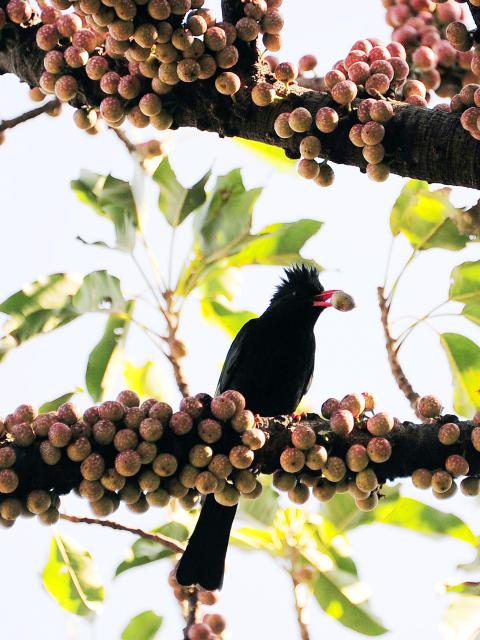Simon Joakim Kiiru remembers a time not long ago when familiar birdsongs filled the air here and life was correlated with bird sightings. His lush, well-tended homestead is in the highlands next to the Aberdare National Park, one of the world’s premier birding destinations.
When the hornbill arrived, Kiiru recalled, the rains were near, meaning that it was time to plant. When a buzzard showed a man his chest, it meant a visitor was imminent. When an owl called at night, it foretold a death.
“There used to be myths because these are our giants,” said Kiiru, 58. “But so many today are gone.”

Photo: Taipei TImes
Over the past two decades, an increasing number of settlers who have moved here to farm have impinged on bird habitats and reduced bird populations by cutting down forests and turning grasslands into fields. Now the early effects of global warming and other climate changes have helped send the populations of many local mountain species into a steep downward spiral, from which many experts say they will never recover.
Over the next 100 years, many scientists predict, 20 percent to 30 percent of species could be lost if the temperature rises by 1.8°C to 2°C. If the most extreme warming predictions are realized, the loss could be over 50 percent, according to the UN climate change panel.
Polar bears have become the icons of this climate threat. But scientists say that tens of thousands of smaller species that live in the tropics or on or near mountaintops are equally, if not more, vulnerable. These species, in habitats from the high plateaus of Africa to the jungles of Australia to the Sierra Nevada in the US, are already experiencing climate pressures and will be the bulk of the animals that disappear.
In response to warming, animals classically move to cooler ground, relocating either higher up in altitude or farther toward the poles. But in the tropics, animals have to move hundreds of kilometers north or south to find a different niche. Mountain species face even starker limitations: As they climb upward they find themselves competing for less and less space on the conical peaks, where they run into uninhabitable rocks or a lack of their usual foods — or have nowhere farther to go.
“It’s a really simple story that at some point you can’t go further north or higher up, so there’s no doubt that species will go extinct,” said Walter Jetz, professor of ecology and evolutionary biology at Yale, whose research last year predicted that 300 of the 1,000 mountain bird species he studied would be threatened because warming temperatures would decimate their habitats.
Birds are good barometers of biodiversity because amateur birdwatchers keep such extensive records of their sightings. But other animals are similarly affected.
Two years ago, scientists blamed a warming climate for the disappearance of the white lemuroid possum, a niche mountain dweller in Australia that prefers cool weather, and that was cute enough to be the object of nature tours. Many scientists, suspecting that the furry animal had died off during a period of unusually extreme heat, labeled the disappearance the first climate-related animal extinction.
Since then, biologists have found a few surviving animals, but the species remains “intensely vulnerable,” said William Laurance, research professor at James Cook University in Australia, who said that in the future heat waves would probably be the “death knell” for a number of cold-adapted species.
For countries and communities, the issue means more than just the loss of pleasing variety. Kiiru regrets the vastly diminished populations of the mythic birds of Kikuyu tribal culture, like buzzards, owls and hawks. But also, the loss of bird species means that some plants have no way to pollinate and die off, too. And that means it is hard for Kiiru to tend bees, his major source of income.
Current methods for identifying and protecting threatened species — like the so-called red list criteria of the International Union for Conservation of Nature, a conservation gold standard — do not yet adequately factor in the impact of probable climate shifts, and the science is still evolving, many scientists say.
Some species that scientists say are at most risk in a warming climate are already considered threatened or endangered, like the Sharpe’s longclaw and the Aberdare cisticola in Kenya. The cisticola, which lives only at altitudes above 2,286m, is considered endangered by the international union, and research predicts that climate change will reduce its already depleted habitat by a further 80 percent by 2100.
Other Kenyan birds that are at risk from climate warming, like the tufted, brightly colored Hartlaub’s turaco, are not yet on watch lists, even though their numbers are severely reduced here. A rapid change of climate can quickly eliminate species that inhabit a narrow niche. On a recent afternoon, Dominic Kimani, a research ornithologist at the National Museums of Kenya, combed a pasture on the Kinangop Plateau for 20 minutes before finding a single longclaw.
“These used to be everywhere when I was growing up,” he said.
He added: “But it’s hard to get anyone to pay attention; they are just little brown birds. I know they’re important for grazing animals because they keep the grasses short. But it’s not dramatic, like you’re losing an elephant.”
As the climate shifts, mountain animals on all continents will face similar problems. Scientists at the University of California at Berkeley recently documented that in Yosemite National Park, where there is a century-old animal survey for comparison, half the mountain species had moved their habitats up by an average of 503m to find cooler ground.
Elsewhere in the US, the pika, the alpine chipmunk and the San Bernardino flying squirrel have all been moving upslope in a pattern tightly linked to rising temperatures. They are now considered at serious risk of disappearing, said Shaye Wolf, climate science director of the Center for Biological Diversity in San Francisco, which in last year applied to protect a number of American mountain species under the US Endangered Species Act.
Last year, new research in the journal Ecological Applications and elsewhere showed that the pika, a thick-furred, rabbitlike animal that takes refuge from the sun in piles of stones, was moving upslope at about 146m a decade and that in the past decade it had experienced a fivefold rise in local extinctions, the term used when a local population forever disappears.
On the Kinangop Plateau in Kenya, Kimani exults when he finds a Hartlaub’s turaco, once a common sight, near Njabini, in a stand of remaining of old growth forest, after engaging local teenagers to help locate the bird. The turaco could lose more than 60 percent of its already limited habitat if current predictions about global warming are accurate, according to Jetz.
“Even substantial movement wouldn’t help them out,” he said. “They would have to move to the Alps or Asian mountains to find their mountain climate niche in the future.”

April 14 to April 20 In March 1947, Sising Katadrepan urged the government to drop the “high mountain people” (高山族) designation for Indigenous Taiwanese and refer to them as “Taiwan people” (台灣族). He considered the term derogatory, arguing that it made them sound like animals. The Taiwan Provincial Government agreed to stop using the term, stating that Indigenous Taiwanese suffered all sorts of discrimination and oppression under the Japanese and were forced to live in the mountains as outsiders to society. Now, under the new regime, they would be seen as equals, thus they should be henceforth

Last week, the the National Immigration Agency (NIA) told the legislature that more than 10,000 naturalized Taiwanese citizens from the People’s Republic of China (PRC) risked having their citizenship revoked if they failed to provide proof that they had renounced their Chinese household registration within the next three months. Renunciation is required under the Act Governing Relations Between the People of the Taiwan Area and the Mainland Area (臺灣地區與大陸地區人民關係條例), as amended in 2004, though it was only a legal requirement after 2000. Prior to that, it had been only an administrative requirement since the Nationality Act (國籍法) was established in

Three big changes have transformed the landscape of Taiwan’s local patronage factions: Increasing Democratic Progressive Party (DPP) involvement, rising new factions and the Chinese Nationalist Party’s (KMT) significantly weakened control. GREEN FACTIONS It is said that “south of the Zhuoshui River (濁水溪), there is no blue-green divide,” meaning that from Yunlin County south there is no difference between KMT and DPP politicians. This is not always true, but there is more than a grain of truth to it. Traditionally, DPP factions are viewed as national entities, with their primary function to secure plum positions in the party and government. This is not unusual

US President Donald Trump’s bid to take back control of the Panama Canal has put his counterpart Jose Raul Mulino in a difficult position and revived fears in the Central American country that US military bases will return. After Trump vowed to reclaim the interoceanic waterway from Chinese influence, US Defense Secretary Pete Hegseth signed an agreement with the Mulino administration last week for the US to deploy troops in areas adjacent to the canal. For more than two decades, after handing over control of the strategically vital waterway to Panama in 1999 and dismantling the bases that protected it, Washington has